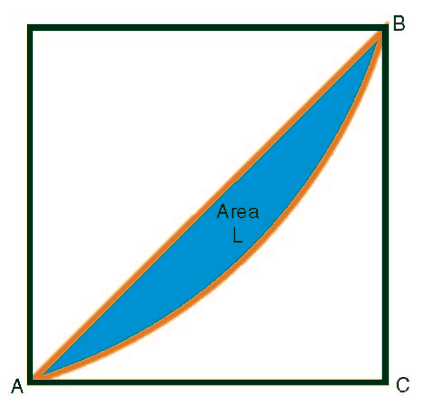Gini Index
The Gini index is one of the most accepted and established methods to measure income inequality.
It converts the Lorenz curve into a number between 0 and 1:
- When the Gini index is 0, there is no inequality; or, in other words, income equality is complete.
- As the Gini index approaches 1, income inequality increases. When the Gini index reaches 1, then income inequality is total: i.e., one family receives all of the country’s income, while everyone else receives nothing.
How to Calculate the Gini Index
Consider the Lorenz curve in the diagram. The Gini calculation is as follows:
Area between the Lorenz curve and diagonal line AB/ Area of the Triangle under the diagonal line (Triangle ABC) = Area L / Area of Triangle ABC

- The area of Triangle ABC under the diagonal line is always fixed and never changes.
- Area L is always smaller than the area of triangle ABC. If one family owned all of the national wealth, the Gini index would be 1.
- When the Lorenz curve shows a high degree of income equality, the area of L will be small, and the Gini index will therefore remain close to 0.
- In a case of complete income equality, the Lorenz curve follows the path of the 45-degree diagonal line. In this situation, Area L is 0, and the Gini index is exactly 0.
Reducing Income Inequality in a Country
One way of reducing income inequality in a country is to tax the wealthy, and to transfer the tax money to the poor. Money taken by the government from the wealthy and given to the poor is called a transfer payment.
Taxes:
There are two types of taxation:
- Taxes levied on income (i.e., income tax).
- Taxes levied on spending (i.e., consumption tax).
Income taxes:
Income taxes are paid on salaries and corporate profits.
Consumption taxes:
Consumption taxes are imposed when goods or services are purchased. The following are the primary types of consumption taxes:
- Luxury Tax.
- Customs duties are taxes levied on imports.
- Purchase taxes are taxes levied on specific products.
- Fuel taxes – are taxes levied on gasoline.
- Cigarette tax is a tax levied on every pack of cigarettes.
Value Added Tax (VAT)
In a VAT tax system, people pay VAT on every product or service purchased. The seller is obligated to collect the tax, and to transfer the money to the government.
For example, if we assume that the VAT rate is 17%, and a product is purchased for $58.50, then this price already includes $8.50 in VAT. The price before VAT was $50.00, and 17% VAT tax was added, increasing the price by a further $8.50. In order to calculate the pre-VAT price, divide the final price by 1 plus the VAT rate. In this case, the VAT rate was 17%, so the final price is divided by 1 + 0.17 = 1.17.
($58.5) / (1.17) = $50
- The difference between the two figures is the VAT paid.


